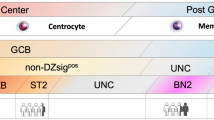Abstract
Recent studies have suggested that one of the polycomb group genes,BMI- 1, has an important role in the maintenance of normal and leukemic stem cells by repressing theINK4a/ARF locus. Here, we quantitatively examinedBMI- 1 expression level in samples from patients with acute myeloid leukemia (AML) and other hematologic malignancies. Moderate to highBMI- 1 expression was detected in AML patients, and theBMI- 1 expression levels in AML samples were significantly higher than in normal bone marrow controls(P =.0011). Specimens of French-American-British classification subtype M0 showed higher relative expression of the BMI-1 transcript (median, 390.2 x 10-3) than the other subtypes (median, 139.0 x 10-3)(P <.0001). Leukemia other than AML showed low to moderate expression. INK4a-ARF transcript expression tended to be inverse proportion to that of BMI-1. In an M0 patient with a high BMI-1 transcript level, the INK4a-ARF transcript level fell promptly and maintained a low value after the patient achieved complete remission. These results indicated that a subgroup of M0 patients has a high expression level of polycomb group geneBMI- 1, which may contribute to leukemogenesis.
Similar content being viewed by others
References
Park IK, Qian D, Kiel M, et al. Bmi-1 is required for maintenance of adult self-renewing haematopoietic stem cells.Nature. 2003;423:302–3055.
Lessard J, Sauvageau G.Bmi-1 determines the proliferative capacity of normal and leukaemic stem cells.Nature. 2003;423:255–260.
Jacobs JJ, Kieboom K, Marino S, DePinho RA, van Lohuizen M. The oncogene and Polycomb-group genebmi-1 regulates cell proliferation and senescence through theink4a locus.Nature. 1999; 397:164–168.
Molofsky AV, Pardal R, Iwashita T, Park IK, Clarke MF, Morrison S.J. Bmi-1 dependence distinguishes neural stem cell self-renewal from progenitor proliferation.Nature. 2003;425:962–967.
van LohuizenM, Verbeek S, Scheijen B, Wientjens E, van der Gulden H, Berns A. Identification of cooperating oncogenes in E mu-myc transgenic mice by provirus tagging.Cell. 1991;65:737–752.
Alkema MJ, Wiegant J, Raap AK, Berns A, van Lohuizen M. Characterization and chromosomal localization of the human proto-oncogene BMI-1.Hum Mol Genet. 1993;2:1597–1603.
Pui CH, Raimondi SC, Murphy SB, et al. An analysis of leukemic cell chromosomal features in infants.Blood. 1987;69:1289–1293.
Berger R, Baranger L, Bernheim A, Valensi F, Flandrin G. Cytogenetics of T-cell malignant lymphoma: report of 17 cases and review of the chromosomal breakpoints.Cancer Genet Cytogenet. 1988;36:123–1300.
Bea S, Tort F, Pinyol M, et al.BMI-1 gene amplification and over-expression in hematological malignancies occur mainly in mantle cell lymphomas.Cancer Res. 2001;61:2409–2412.
Vonlanthen S, Heighway J, Altermatt HJ, et al. The bmi-1 oncoprotein is differentially expressed in non-small cell lung cancer and correlates with INK4A-ARF locus expression.Br J Cancer. 2001; 84:1372–1376.
Dimri GP, Martinez JL, Jacobs JJ, et al. TheBmi-1 oncogene induces telomerase activity and immortalizes human mammary epithelial cells.Cancer Res. 2002;62:4736–4745.
Hirose Y, Kiyoi H, Itoh K, Kato K, Saito H, Naoe T. B-cell precursors differentiated from cord blood CD34+ cells are more immature than those derived from granulocyte colony-stimulating factor-mobilized peripheral blood CD34+ cells.Immunology. 2001; 104:410–417.
Jen J, Harper JW, Bigner SH, et al. Deletion of p16 and p15 genes in brain tumors.Cancer Res. 1994;54:6353–6358.
Voncken JW, Schweizer D, Aagaard L, Sattler L, Jantsch MF, van LohuizenM. Chromatin-association of the Polycomb group protein BMI1 is cell cycle-regulated and correlates with its phosphorylation status.J Cell Sci. 1999;112(pt 24):4627–4639.
Bonnet D, Dick JE. Human acute myeloid leukemia is organized as a hierarchy that originates from a primitive hematopoietic cell.Nat Med. 1997;3:730–737.
Xia ZB, Anderson M, Diaz MO, Zeleznik-Le NJ. MLL repression domain interacts with histone deacetylases, the polycomb group proteins HPC2 and BMI-1, and the corepressor C-terminal-binding protein.Proc Natl Acad Sci USA. 2003;100:8342–8347.
Drexler HG. Review of alterations of the cyclin-dependent kinase inhibitor INK4 family genes p15, p16, p18 and p19 in human leukemia-lymphoma cells.Leukemia. 1998;12:845–859.
Author information
Authors and Affiliations
Corresponding author
About this article
Cite this article
Sawa, M., Yamamoto, K., Yokozawa, T. et al. BMI-1 is Highly Expressed in M0-Subtype Acute Myeloid Leukemia. Int J Hematol 82, 42–47 (2005). https://doi.org/10.1532/IJH97.05013
Received:
Revised:
Accepted:
Published:
Issue Date:
DOI: https://doi.org/10.1532/IJH97.05013




